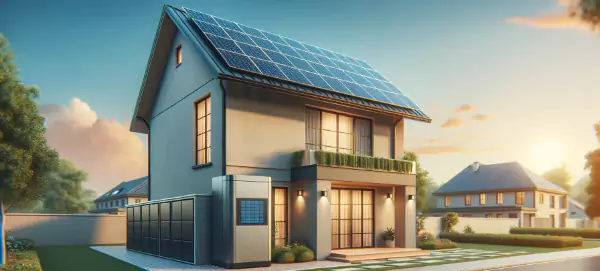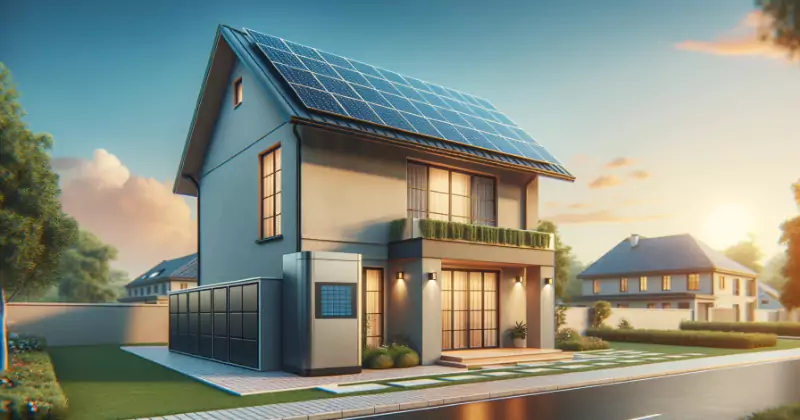In the southern hemisphere solar photovoltaic (PV) panels are usually mounted in a northerly facing direction to gain the maximum amount of sunlight possible hitting the surface of the panels.
Roof mounted solar PV panels convert the energy in sunlight into electricity using the photovoltaic effect. The conversion takes place within the solar modules that are constructed from unique materials like Crystalline silicon and Monocrystalline silicon, solar panels have no moving parts and are a relatively simple piece of hardware. The DC electricity from the solar panels can be passed through an inverter and changed into AC electricity more suitable for household use.
Solar PV panels are not the same as solar hot water panels which use the suns heat to raise the temperature of the water flowing through the panels hollow tubes.
The science of converting sunlight into electricity was first developed in the 19th century. However, it was not until the second half of the 20th century that the development of solar technology accelerated with the need to provide reliable power supplies for remote locations and satellites in space. The low cost of fossil fuels also played a part in retarding the development of solar energy technology for much of the 20th century.
In Australia solar panels first started to appear back in the 1970s, today there are estimated to be close to 1.5 million small-scale rooftop mounted solar power systems supplying electricity to homes and businesses across Australia.
Grid connect solar power systems
Most homes in Australia have connected to a local electricity grid via cables on power poles or underground power cables supplying alternating current (AC) electricity. Solar panels can only produce direct current (DC) which is the same type of electricity in your car battery. Because of this most systems will have a power inverter installed that converts the DC power into AC for both home use and for feeding back into the power grid.
A grid-connect system will automatically draw power from the solar panels for consumption and switch over to pull electricity from the network only when the panels are not producing electricity.
Solar power systems with batteries can charge the battery bank during the day and make use of the solar energy stored in the batteries at night.
So-called hybrid solar power systems have both a grid connection and a bank of deep cycle batteries.
Average solar PV power output
The average amount of electricity a solar PV system can produce depends on the overall system efficiency and the amount of sunlight for the system location. Below is a table showing average system output around Australia:
| City | 1 kW system | 1.5 kW system | 2.0 kW system | 3.0 kW system | 4.0 kW system |
|---|---|---|---|---|---|
| Adelaide | 4.2 kWh | 6.3 kWh | 8.4 kWh | 12.6 kWh | 16.8 kWh |
| Alice Springs | 5.0 kWh | 7.5 kWh | 10.0 kWh | 15.0 kWh | 20.0 kWh |
| Brisbane | 4.2 kWh | 6.3 kWh | 8.4 kWh | 12.6 kWh | 16.8 kWh |
| Cairns | 4.2 kWh | 6.3 kWh | 8.4 kWh | 12.6 kWh | 16.8 kWh |
| Canberra | 4.3 kWh | 6.45 kWh | 8.6 kWh | 12.9 kWh | 17.2 kWh |
| Darwin | 4.4 kWh | 6.6 kWh | 8.8 kWh | 13.2 kWh | 17.6 kWh |
| Hobart | 3.5 kWh | 5.25 kWh | 7.0 kWh | 10.5 kWh | 14.0 kWh |
| Melbourne | 3.6 kWh | 5.4 kWh | 7.2 kWh | 10.8 kWh | 14.4 kWh |
| Perth | 4.4 kWh | 6.6 kWh | 8.8 kWh | 13.2 kWh | 17.6 kWh |
| Sydney | 3.9 kWh | 5.85 kWh | 7.8 kWh | 11.7 kWh | 15.6 kWh |
The rated output is that achieved in perfect laboratory conditions. The Clean Energy Council design summary software takes these de-ratings into account when predicting averages for any given system. Panels generate more electricity in summer than in winter. The table above reflects the electricity generated averaged across the whole year.
An average Australian home uses roughly 18.5 kWh of power each day; a 1 or 2kW solar PV system may reduce your electricity bill by 24% to 41%
Solar PV system design
The wattage of a solar panel defines the maximum possible output per hour (kWh), so 4 x 250W solar panels will make a total of 1kW of power per hour. Solar panels will never run at 100% efficiency, there will always be some loss due to resistance in the cabling and at the inverter, also the angle of the panels and the time of year. A good solar panel installer who is worth his or her salt will be able to maximise system output by finding the absolute best possible angle for the panels.
The angle of solar panels
To gain the most power output from a solar panel it needs to be aimed directly at the sun. Australian solar modules should face north for maximum electricity production. Solar panel orientation is an essential factor with overall system output and just as important as the tilt angle. A good practice is to have at least 10° of tilt to ensure rainfall runoff which can help keep the panels self-clean.
Grid connect solar power systems should have panels that are installed at the angle of latitude increasing the annual system output, average Australian roof pitches are 20° to 30°.
If you have a flat roof, your accredited solar installer should be able to install some mounting frame to get the right angle. In the northern parts of Australia strict standard apply to solar panel mounting due to the possible impact of strong wind events such as cyclones, a free solar panel in a storm can become a dangerous projectile.
Designing a solar PV system for maximum efficiency
The daily sunlight a solar panel receives is referred to as peak sun hours. The amount of electricity a solar panel can produce is relating to the amount of peak sun hours, so it is essential to install the panels in a position that get the most sun and as little as possible shade from trees or nearby buildings obscuring the sun.
Your accredited solar installer will be able to calculate the output of your solar panels based in the peak sun hours, note that peak sun hours change at different times of the year.
Shade and dust can affect solar panel output
In a perfect world, solar panels would be mounted in a position that exposes them to full sunlight from 9 am to 3 pm, the shade should be avoided, and panels need to be kept clean and free of dust and dirt.
Even a small amount of shade can have a significant impact on the way electricity flows through the solar modules in the panel, so try to avoid any shadow at all no matter how small it seems, no sun means no power. One shaded cell will affect the output of the others around it.
For more information about installing a solar PV system visit SolarQuotes.com.au

